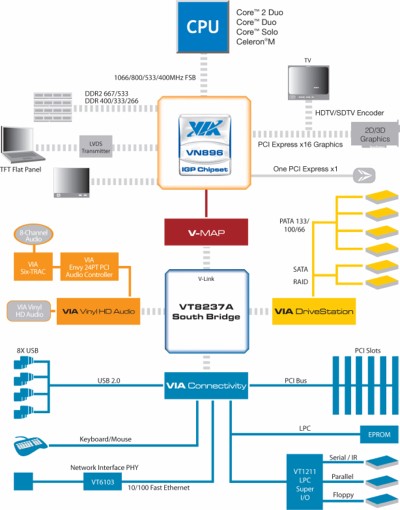2D/3D graphics chipset targets mobile devices
Jan 26, 2007 — by LinuxDevices Staff — from the LinuxDevices Archive — views Via Technologies is shipping a new mobile graphics processor chipset targeting notebook and ultra-mobile PCs. The VN896 chipset integrates 3D and 2D accelerators, offers “unsurpassed visual clarity,” and supports modern Intel processors ranging from the Celeron M to Core 2 Duo, as well as Via's C7.
Via Technologies is shipping a new mobile graphics processor chipset targeting notebook and ultra-mobile PCs. The VN896 chipset integrates 3D and 2D accelerators, offers “unsurpassed visual clarity,” and supports modern Intel processors ranging from the Celeron M to Core 2 Duo, as well as Via's C7.
Via is marketing the VN896 as being certified “Vista Basic Ready.” However, at a quick glance, Linux support appears to available for most if not all of the IP (intellectual property) on the chip, including the Chrome9 HC integrated graphics processor (IGP). In the past, Via has offered Fedora Core drivers for Chrome9 implementations in its P4M900 and K8M890 chipsets, and 2D acceleration may also be available through pure open source drivers such as OpenChrome.
The VN896's Chrome9 IGP implements both a 2D accelerator and a high-performance, DirectX 9.0 3D accelerator. Via claims that its 3D graphics engine implementation is unique in its ability to provide simultaneous usage of single-pass multitexturing and single-cycle trilinear filtering, resulting in “stunning” image quality without performance loss. Again, however, taking advantage of the chip's 3D acceleration likely involves dealing with a binary-only Linux driver from Via.

VN896 block diagram
(Click image for larger view)
The chipset is optimized for ultra-low power consumption, and implements dynamic CKE and clock grating to minimize DDR SDRAM power consumption for maximum battery life in mobile devices, according to Via. When paired with the Via C7-M processor, the VN896 supports “Via PowerSaver,” which acts as a throttle to lower the CPU's frequency and voltage when the workload is light, reducing overall CPU power consumption by up to 50 percent, the company adds.
A high bandwidth “Via V4” bus supports communication between the chipset's North and South bridges at 533MB/sec. When combined with South bridges like the VT8237A or VT8237R Plus and related companion chips, the VN896 provides a “comprehensive range” of storage, multimedia, and connectivity features, including native Serial ATA, LVDS, TV encoder, support for 6-channel or 8-channel Via Vinyl Audio, VIA Velocity Gigabit Ethernet and wireless LAN connectivity, USB 2.0, and 1394, according to Via.
Via VP of product marketing Chewei Lin stated, “As computing increasingly goes mobile, the VN896 mobile chipset offers unparalleled visual quality for a rich digital media experience. Coupled with its advanced power saving features, it's an excellent choice for notebooks and even smaller, ultra mobile devices requiring superior performance and extensive peripheral connectivity.”
This article was originally published on LinuxDevices.com and has been donated to the open source community by QuinStreet Inc. Please visit LinuxToday.com for up-to-date news and articles about Linux and open source.